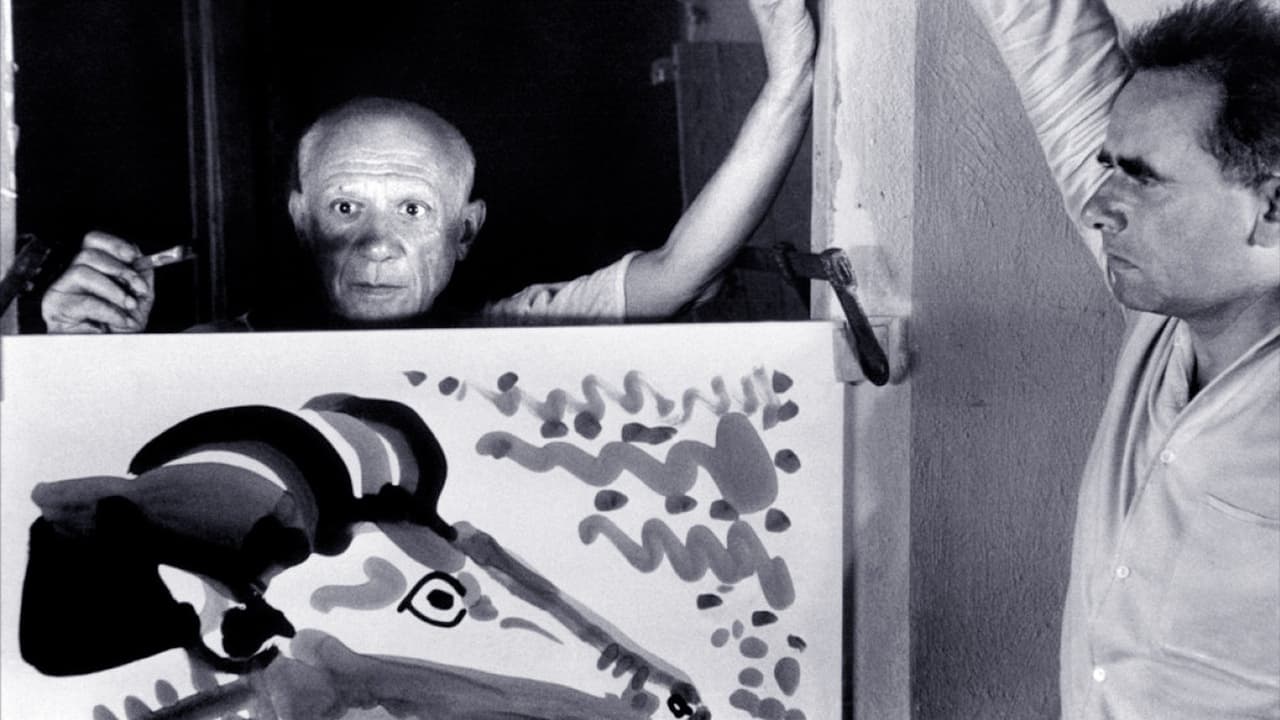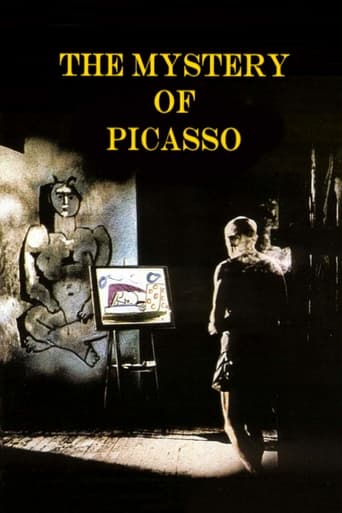



just watch it!
a film so unique, intoxicating and bizarre that it not only demands another viewing, but is also forgivable as a satirical comedy where the jokes eventually take the back seat.
View MoreThis is a coming of age storyline that you've seen in one form or another for decades. It takes a truly unique voice to make yet another one worth watching.
View MoreThere's a more than satisfactory amount of boom-boom in the movie's trim running time.
View MoreDirector Henri-Georges Clouzot, best known in America for his expert thrillers (Diabolique, The Wages of Fear, Le Corbeau) captures a different kind of suspense in this astonishing documentary: can the viewer think faster than Picasso?Of course not, don't be ridiculous. Pablo Picasso, seen here in his seventies, creates 20-odd paintings for the camera (a couple of them in real time), running rings around us as he goes. We see a line cross the screen, and then another, and then color spatters about; drawn on bleed-through paper the images come to us unmediated, like daydreams. Before we know it scenes take shape, populated by Picasso's stock company of matadors, clowns, leering old men, and towering, serene, bare-breasted women, their faces regally aloof.This is Picasso Playful. Clouzot informs him at one point that there are only five minutes of film left and asks him what he wants to do. The old man replies "It'll be a surprise," quickly sketching a bouquet of roses and then taking it through acrobatic transformations, faking us out with deadpan glee. His buoyancy counterweights some of the director's more awkward touches, such as the portentous intro, some over-dramatic music, a few probably staged conversations... but who cares? This is dynamic, visual cinema-- in a sense, a great animated film.Some of the earlier drawings are merely a master's doodles; others make your jaw drop with their absolute sureness of line. He'll send a stroke wriggling upward, graceful as a ribbon of smoke, and suddenly that wriggle is a bull with man tossed on its horns, and as the shapes gather and the colors erupt the thing becomes impossibly beautiful, a small perfection. Picasso returns to the image later, breaking out the oils, and here the film truly takes off. "I want to go deeper," Picasso tells Clouzot, and he does. We realize what we were missing in those first drawings: texture. The head of a goat coheres and takes on animal reality, the pigments bright as stained glass. Picasso ages it, makes it solid. What would be a major work for a lesser artist here is a throwaway, literally; the paintings were destroyed after filming. The least of them could have paid for my house.In that intro Clouzot says something about "looking into the mind of the artist" or somesuch, but the title really says it all. At the beginning the artist saunters out shirtless from the studio's shadows. At the end he declares, "It is finished," and saunters back. What could possibly account for the existence of a Pablo Picasso remains a mystery untouched.
View MorePeter Greenaway was right. A work of art is never finished, only stopped.Mystery of Picasso is an incredible film that unveils the painter's ingenious techniques and is just as suspenseful and intriguing as anything else Clouzot ever did.The greatest art form of the 20th century records the greatest artist of the 20th century. Only Cinema could breathe this kind of life into the work of the master.Picasso attacks the canvas like a man possessed, tapping an infinite reservoir of imagination and creativity.He reworks and reinvents his paintings over and over again. The stop-motion techniques find perfect expression here and make the film seem less like live-action and more like a work of animation. Picasso's canvases are transformed into organic living creatures - in a constant state of metamorphosis and evolution.The best part about having this on DVD is the option of the viewer in deciding when enough is enough. All you have to do is hit the pause button and admire the masterpiece before you.The film is a perfect synthesis of an artist and a filmmaker - both at the height of their creative powers.
View MoreOne of the greatest filmmakers of France, Henri-Georges Clouzot, makes a film about his friend Pablo Picasso, perhaps the 20th Century's most renown artist. Clouzot begins with a proposition: if one were present at the conception of a great artistic masterpiece such as Mozart's Jupiter Symphony, and could peek inside the mind of the artist, what would one see? Fortunately, the visual art of painting offers a filmmaker that insight, and so Clouzot begins with Picasso in a dark room with white light directed at an empty canvas. The artist, like a bullfighter, confronts and ultimately displaces the empty space with drama and suspense. Clouzot takes a minimalist approach which chooses to focus on the art rather than the artist, and he achieves this objective by having Picasso sit on one side of a translucent canvas, and the camera on the other capturing only the ink or paint that has been administered, without the distraction or impediment of the artist - pure creation. A window into the mind of the artist! Twenty artworks are created in this manner, each being overlayed with the often suspenseful sounds of Georges Auric's excellent score. With THE MYSTERY OF PICASSO, art becomes exhilarating as one attempts to anticipate what Picasso will do next. "How will he resolve this problem?" Clouzot has created a priceless document for anyone seriously interested in art.
View MoreHenri-Georges Clouzot's The Mystery of Picasso starts by announcing that we will have the pleasure of entering the mind of Pablo Picasso, seeing how he gets his creative inspiration; the film promises us that the only way to do this is to watch Picasso's hand. Picasso paints on paper that the ink bleeds through, putting the camera on the other side of Picasso's canvas and watching the a reversed version painting appear in a seemingly magical way. It becomes clear early on that Clouzot is not wholeheartedly trying to show us how Picasso gets his inspiration; that is a mystery. Clouzot wants to capture the joy of painting. That's what makes this film so entertaining: watching bizarre, beautiful images appear out of nowhere. Sometimes Clouzot uses jump-cuts to show us the different phases of a work in progress at a rapid-fire velocity and then reverses the painting in the same jump-cut technique, deconstructing Picasso's. This is all scored to fiery jazz music. We also see Picasso while painting, as his painting is timed. (Picasso has a great screen presence). Clouzot is equally concerned with deconstructing Picasso's work to understand what makes this fast-working artist tick, showing how impossible that task is, and wowing us all the way through. As far as wowing goes, Clouzot did a pretty good job, with scenes that ranged from unforgettable to pleasantly surprising.
View More